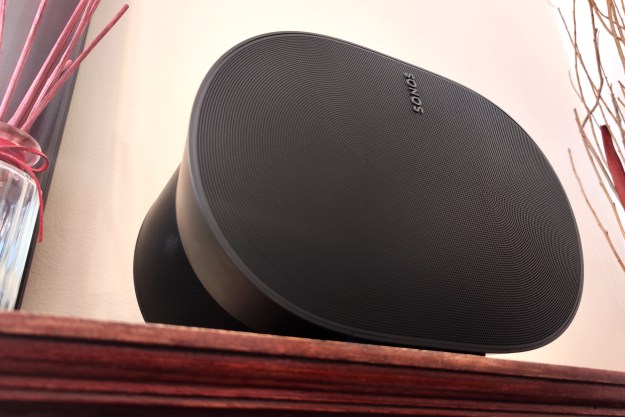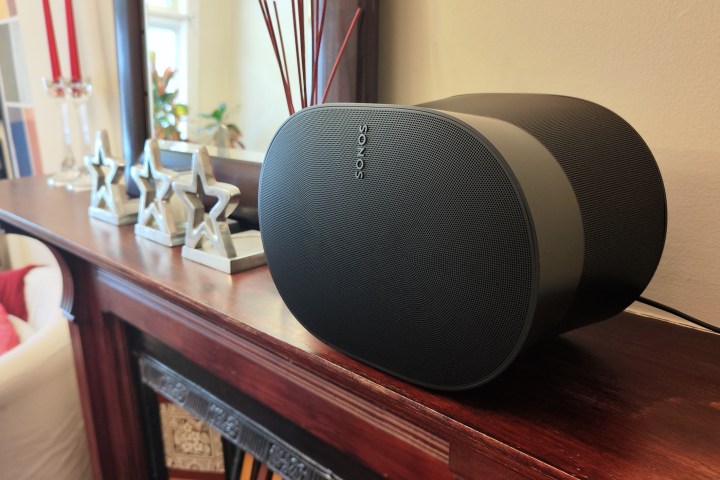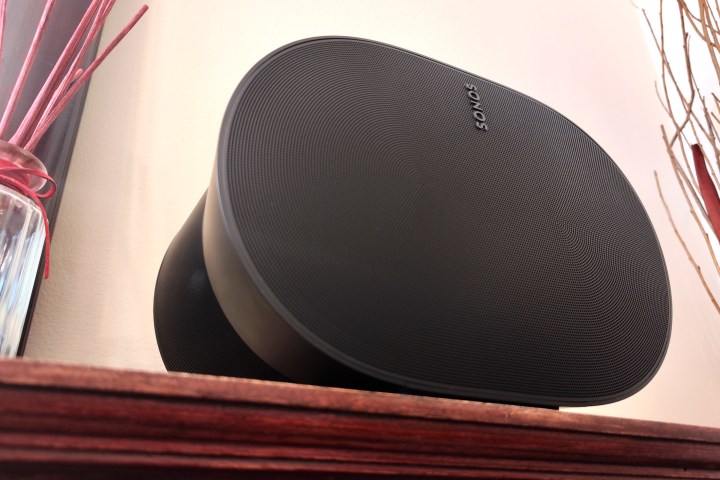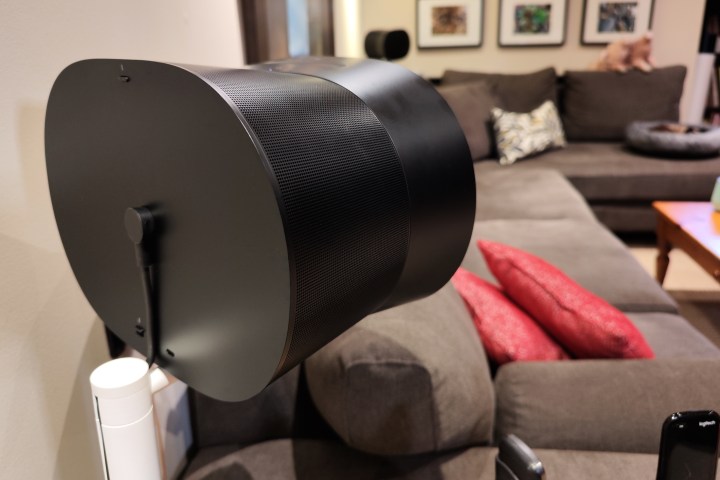
- Dolby Atmos Music-compatible
- Incredible, immersive sound
- Easy, fast room tuning
- Perfect as home theater surrounds
- Line-in for analog sources
- Bluetooth, AirPlay 2
- No Google Assistant
The Sonos Era 300 doesn’t look like any ordinary wireless speaker. And with its collection of six drivers, arranged in a pattern that radiates sound in four directions at once, it definitely doesn’t sound like one either. That’s because it’s been built to take advantage of spatial audio, specifically Dolby Atmos Music — an immersive 3D surround sound format that, until recently, could only be experienced using headphones or (if you had all of the right equipment) a pricey Dolby Atmos-capable home theater system or soundbar.
- Video review
- Not your average speaker
- Better controls and indicators
- Powerful smarts
- All of the connections
- External devices, too
- As easy as it gets
- Room tuning for everyone
- This. Sounds. Awesome.
- Immersive or ambient?
- Not for your TV
- We’re going to need a better search
- If one is good, two are spectacular
- Stellar surrounds
What happens when you load up a compact, $449 smart speaker with all of those drivers and then feed it a source of Dolby Atmos Music? Pure magic.
And I predict that once you hear it, you’ll only part with it if we pry it from your cold, dead hands.
Video review
Not your average speaker

In keeping with the rest of the Sonos home speaker lineup, you can buy the Era 300 in either black or white. They both look great, with their understated, all-plastic exteriors. But if you suffer from a fingerprint allergy, I recommend the white version — the black finish has a tendency to show even the faintest of marks on its smooth beltline.
Though certainly eye-catching, the Era 300’s unusual hourglass shape isn’t simply Sonos trying to make a statement. The design allows five of the speaker’s six drivers to aim sound both outward and slightly forward. If you picture the speaker sitting in the center of a flower, with the petals representing the sound, you’ll get the idea.
It’s a clever solution that lets the speaker to do what it does best — don’t worry, I’ll get to sound quality in a moment — but it also means you’ll need to give it plenty of room to breathe. Placing the Era 300 in a bookshelf (or anywhere that might block the sides or top) would be less than ideal.
Not that there are many bookshelves that would handily accommodate it. At 6.3 inches tall, 10.2 inches wide, and 7.2 inches deep, the Era is compact for a speaker of its capabilities, but it’s not exactly small.
Better controls and indicators

Atop the speaker are Sonos’ newly redesigned touch controls, which separate track skipping and volume functions, making both easier and more accurate to use. The grooved volume slider is an especially satisfying control, bringing an almost analog feel to loudness adjustments. You’ll also find two ways to control the built-in mics: a quick tap-to-mute control on top and a microphone kill switch on the back panel that physically disconnects the mic circuit for the ultimate in privacy. (Sonos has no plans at the moment to introduce a mic-free “SL” variant of the 300.)
I noted in my review of the Era 100 that I think Sonos should consider adding backlights to these controls to make them easier to find in darkened rooms. After all, with its relatively small footprint, the Era 100 could easily be placed on a nightstand. I doubt many folks will do that with the Era 300.
The LED Sonos uses to indicate things like voice assistant response, muting, and software updates is now visible from the front of the speaker, behind the grille, where it can be seen from any vantage point. That’s a big improvement over the previous top-surface location it used on its previous speakers.
Powerful smarts

I won’t say that the Era 300 is the most powerful Sonos smart speaker — that title belongs to the Sonos Arc soundbar — but it is the most powerful music-oriented smart speaker in the company’s lineup. The Sonos Five ($549) packs a bigger punch, but it’s not a smart speaker.
You can choose to run either Amazon Alexa or Sonos’ homegrown Sonos Voice Control (SVC) assistants (or both simultaneously) on the Era 300; Google Assistant isn’t available. That might not be a permanent situation — many of Sonos’ other smart speaker models offer Google’s AI — but the current relationship between Sonos and Google is a tense one and it may be a while before they reconcile their differences.
The Sonos Era 300 gives new meaning to “fills a room with sound.”
Google’s absence notwithstanding, the Era 300 works really well with Alexa and SVC. The microphone array has no trouble picking up your voice from across the room, and as long as you’re not blasting the tunes, it can even hear you over the sound of music playing.
At the moment, Alexa is the better choice if you use streaming services like Spotify, Tidal, TuneIn, or YouTube Music, while SVC works well with Apple Music, Amazon Music, Deezer, Pandora, and Sonos’ own Sonos Radio. Where SVC really comes in handy is its Sonos-specific skills, like grouping and ungrouping speakers or accessing your Sonos playlists.
All of the connections

The Era 300 and Era 100 are the first Sonos home speakers with Bluetooth. And for folks who have been stuck in the pre-Bluetooth Sonos “era,” it’s a breath of fresh air. A long press on the dedicated Bluetooth button on the back of the speaker is all it takes to put the Era 300 into pairing mode, and from there you can connect any Bluetooth device and start streaming. Sonos hasn’t equipped with the 300 with hi-res capable Bluetooth codecs (just SBC and AAC), however.
You will notice that Bluetooth sessions don’t sound quite as good as those that are started from the Sonos app, so this shouldn’t be your go-to for critical listening. But it finally lets your visiting friends play music on your Sonos system without having to share Wi-Fi passwords or download the Sonos app.
You have not really heard the Era 300 until you play tracks in Dolby Atmos Music.
It’s also remarkably flexible. Unlike the Sonos Move, which has to abandon its Wi-Fi connection to use Bluetooth, you can run the Bluetooth connection on the new Era speakers at the same time as Wi-Fi, leaving you the ability to control their settings from the Sonos app. With that Wi-Fi connection still active, Bluetooth streaming sessions to the Era 300 can be shared with any other Sonos speaker in the house.
Before you ask, yes, the Era 300 and 100 can both be used as standalone Bluetooth speakers. Some select SVC commands are still available, though not right out of the box. A Wi-Fi-connected first-time setup is a prerequisite before you can do any Bluetooth streaming. But that’s a small thing because you’re almost certainly going to set up these speakers with Wi-Fi anyway — that’s how Sonos works.
Want lossless streaming without using the Sonos app? Apple devices can do so using AirPlay 2 at CD-quality 16-bit/44.1kHz, while Tidal Hi-Fi subscribers can use Tidal Connect on any device to stream hi-res, 24-bit/48kHz tracks. Spotify Connect also is supported, which pretty much just leaves out Google’s Chromecast wireless audio platform. And given how things are going with Google, I don’t expect that to change any time soon.
External devices, too

Sonos’ previous home speakers have been a bit stingy when it comes to external connections. They lacked Bluetooth, and unless you were willing to spend big dollars on the Sonos Five, there was also no way to connect an external source of audio like a turntable. That might have been understandable in the mid-2000s when Sonos was first establishing its presence as the leading wireless audio system. But in 2023, when vinyl is outselling CDs for the first time in decades, it’s a real limitation.
It’s about time Sonos added better support for peripherals.
Sonos has clearly been reading the room because you can add a $19 line-in adapter to the Era 300’s USB-C port that accepts any 3.5mm analog connection. Turntables will still need a preamp if they don’t have one built-in (and probably a stereo RCA-to-3.5mm patch cord), but once connected, you’ll be able to spin records or any other analog audio and listen on the Era 300. Better yet, that line-in adapter is visible from within the Sonos app and can be accessed by any Sonos speaker, even if the Era 300 isn’t playing.
There’s also a $39 combo adapter that adds an Ethernet jack to the 3.5mm input, for those who want to use a wired connection to their network.
Sonos has said zilch about digital audio adapters, but I’m hopeful this will happen given that the USB-C plug is already a digital interface.
As easy as it gets
Sonos fans already know how brilliantly simple the company’s products are to set up, and the Era 300 is no exception. If anything, it’s the easiest so far. Download and install the Sonos app and create an account (if you haven’t done so already), then plug the speaker into the wall and let the app do the rest.
It automatically finds the speaker, confirms that you want to set it up, and rapidly guides you through the process of getting connected to your Wi-Fi network and choosing a name and location for the speaker — all without having to enter a single password or press weird button combinations on the Era. Two minutes (at the most) and you’re in business. Maybe a few more if you have to add your streaming services to the Sonos app.
Room tuning for everyone
Another major improvement on the Era 300 is Sonos’ revamped Trueplay room-tuning system. As on previous speakers, this automatically rebalances EQ to take a room’s specific acoustics into consideration. But now, you no longer need an iPhone to do it. Android and iPhone users can both avail themselves of a new quick-tuning version of Trueplay that leverages the Era’s built-in mics instead of the ones on your phone.
It’s fast, it’s easy, and I’m not sure I can tell the difference between this approach and the “advanced tuning” option that can still be accessed if you have an iPhone.
This. Sounds. Awesome.

I’m not a fan of hyperbole. A product can be good or even great without needing additional descriptors like “epic,” or “game-changing.” But if ever there were a product that could justify these superlatives, it’s the Era 300.
When playing traditional stereo music, it’s already one of the best wireless speakers you can buy. There’s excellent separation between frequencies. And the highs are clear, with just a touch of sparkle, the mids aren’t trampled, so you can make out much of the detail, and you will not believe the bass this thing kicks out. I demoed it for my colleague, Derek Malcolm, and he pointed to the Sonos Sub in the corner and said, “great! Now let’s hear it without the sub.” The look on his face when I told him the sub wasn’t connected was priceless.
However, you have not heard half of what the Era 300 can do until you play tracks that have been created in Dolby Atmos Music.
You might have to convince friends you don’t have a dedicated subwoofer in the room.
A track like The Weeknd’s Blinding Lights, when streamed from Tidal Hi-Fi, sounds great, no question. But flip to Amazon Music Unlimited’s Dolby Atmos Music version of the same track and, suddenly, the sound expands outward and upward, taking what was already a decent soundstage and then magnifying it, making it nearly impossible to identify the source of the sound with your eyes closed. I’ve heard sound like this from a soundbar, but never from a music speaker.
One of the hallmarks of Dolby Atmos for movies is its ability to move individual sounds around a room and not just switch the direction from which it’s coming at you. That effect increases the realism of the on-screen action as what you see and what you hear match up in 3D space. For Dolby Atmos Music, the intent is different, but no less effective — it places you within the music, letting a band tell a subtly different story with their voices and instruments by adjusting how you relate to them beyond a simple left-right presentation.
To my mind, there’s no better example of this than the Dolby Atmos remaster of the classic Doors track Riders on the Storm. In stereo, the rainfall and thunder certainly add to the mood. But in Atmos, they become cinematic — the sonic backdrop against which the events of the song then unfold. The Era 300 gives you front-row seats.
Want a different kind of front-row experience? Fire up the live, Dolby Atmos version of John William’s The Imperial March (otherwise known as Darth Vader’s theme) from Star Wars and prepare for hairs on the back of your neck to stand up.
Not every Dolby Atmos Music track uses this format to its best advantage. I was disappointed, for instance, with an Atmos version of Alanis Morissette’s mega-hit You Oughta Know. But, to be fair, it was still better than the stereo version.
At the moment, there are only two other non-soundbar speakers that work with Dolby Atmos Music: Amazon’s $199 Echo Studio and Apple’s $299 HomePod Gen 2. Of those two models, I was only able to compare the Era 300 to the HomePod. But based on that pairing, I feel confident telling you that those other smart speakers can’t hold a candle to the Era. Given the price differences, I’d be shocked if that were not the case.
Immersive or ambient?

If there’s one consideration with a speaker like the Era 300, particularly when listening to Dolby Atmos Music, it’s location. Or, to be more specific, your location relative to the speaker. To really get the full benefit of Dolby Atmos’ immersive qualities, you need to be seated directly in front of the Era so it can wrap you in sound (back to that flower analogy from the intro). In this way, it’s similar to listening to a properly separated set of stereo speakers.
However, you can still benefit from Atmos tracks even if you’re not in the speaker’s sweet spot. Instead of getting an immersive experience, it becomes an ambient one. I tried the stereo-versus-Atmos comparison while walking from room to room, as well as listening from an adjacent room, and it’s remarkable how much the Atmos version is able to pervade the space. When we say a speaker can “fill a room with sound,” that expression takes on new meaning with the Era 300.
Not for your TV
After experiencing Dolby Atmos Music on the Era 300, it’s almost impossible not to wonder what this speaker would be like as a Dolby Atmos soundbar connected to a TV. Sadly, however, that’s not a scenario Sonos currently supports (at least, not without a Sonos soundbar). The good news is that if Sonos ever changes its mind, that handy USB-C port can probably be equipped with an HDMI input. Never say never.
We’re going to need a better search

Listening to Dolby Atmos Music on the Era 300 is so good, it highlights a weakness that I hope Sonos is able to fix quickly: it can be very hard to find and identify Dolby Atmos Music tracks, even though there are only two services that currently make them available via Sonos: Apple Music and Amazon Music.
There’s no way to filter search results by the format, no way to identify an Atmos version of a track from its stereo equivalent until you actually play it, and no reliable keywords that can be used to find these tracks.
What’s even more frustrating is that if you find an Atmos track and then head to the full album in the hope that the rest of the tracks are also in Atmos, you’ll be disappointed more often than not. For now, your best bet is to search for “spatial audio” and peruse the playlists that pop up on both music services.
Sonos is aware of the problem and says it is working closely with both Amazon and Apple to make it better.
If one is good, two are spectacular
It probably goes without saying, but I’ll say it anyway: two Era 300s configured as a stereo pair takes the experience to the next level. It’s not cheap — we’re talking about an $898 investment — and yet, if you were to make this your primary music listening setup, I think it’s worth it.
Calling it a stereo pair in the context of Dolby Atmos Music doesn’t really make sense, so let’s say it’s a stereo pair when playing stereo tracks and a spatial audio pair when playing Atmos content.
Instead of just blasting all drivers on both speakers, Sonos deemphasizes the inward-facing drivers while keeping the outward ones going at regular strength; it’s kind of like taking a single Era 300 and stretching it out between the left and right positions, but with more overall potency.
Stellar surrounds

If you have a Sonos home theater setup based on a Sonos Arc and perhaps a Sonos Sub, you have a decent 5.1.2 Dolby Atmos system. If you’ve added a set of Sonos Ones as surrounds, I’ll bet it sounds even better. But a system that combines the Arc, the Sub, and a set of Era 300s as surrounds is an absolute showstopper. (It’s also very expensive.)
Thanks to the embedded height drivers in the Era 300s, it becomes the first Sonos system to deliver 7.1.4 Dolby Atmos (two front-heights and two rear-heights), and the Era’s additional side-firing drivers make them ideal companions to the Arc’s already impressive virtual surround channels.
They’re almost comically large when used as surrounds, but once you hear them you’ll forget about their size. Even in my smallish basement media room, where I could not quite position the Eras as far behind my seating area as Sonos recommends, the sound was spectacular.
My go-to Dolby Atmos movie clips (the Aston Martin chase scene from No Time To Die, the first sandworm scene from Denis Villeneuve’s Dune, the Daytona race scene from Ford v Ferrari, and the initial chase scene from Mad Max: Fury Road) all sounded as good or better than I have ever heard them. The orchestral scenes from 2022’s Tár hit with an emotional punch that left me breathless.
It’s a big line item on your credit card statement if you were to buy them all at once — Sonos calls the $2,471 bundle the “ultimate immersive set with Arc.” But if you’re already a Sonos customer, it makes more sense than switching to a similar system from Sony, LG, or Samsung.
If you are still in any doubt as to whether you should buy the Sonos Era 300 or not, let me be perfectly clear: you should buy it. Heck, if you can afford it, you should buy two. I say this whether you are currently a Sonos owner or you’ve never even listened to a Sonos speaker before. It’s an amazing speaker controlled by an amazing app (our Sonos explainer gets into all of those details), and when you take into consideration its smart speaker abilities, Bluetooth, and line-in options, the fact that it’s missing Google Assistant seems an almost petty critique.
Just do me a favor and promise me that if you do buy the Era 300, you will also sign up for either Amazon Music or Apple Music (preferably, in my opinion, Amazon Music) so that you can experience this speaker the way it’s meant to be heard — with a nonstop playlist of Dolby Atmos Music.















